Treatment options for Chiari malformation and Syringomyelia
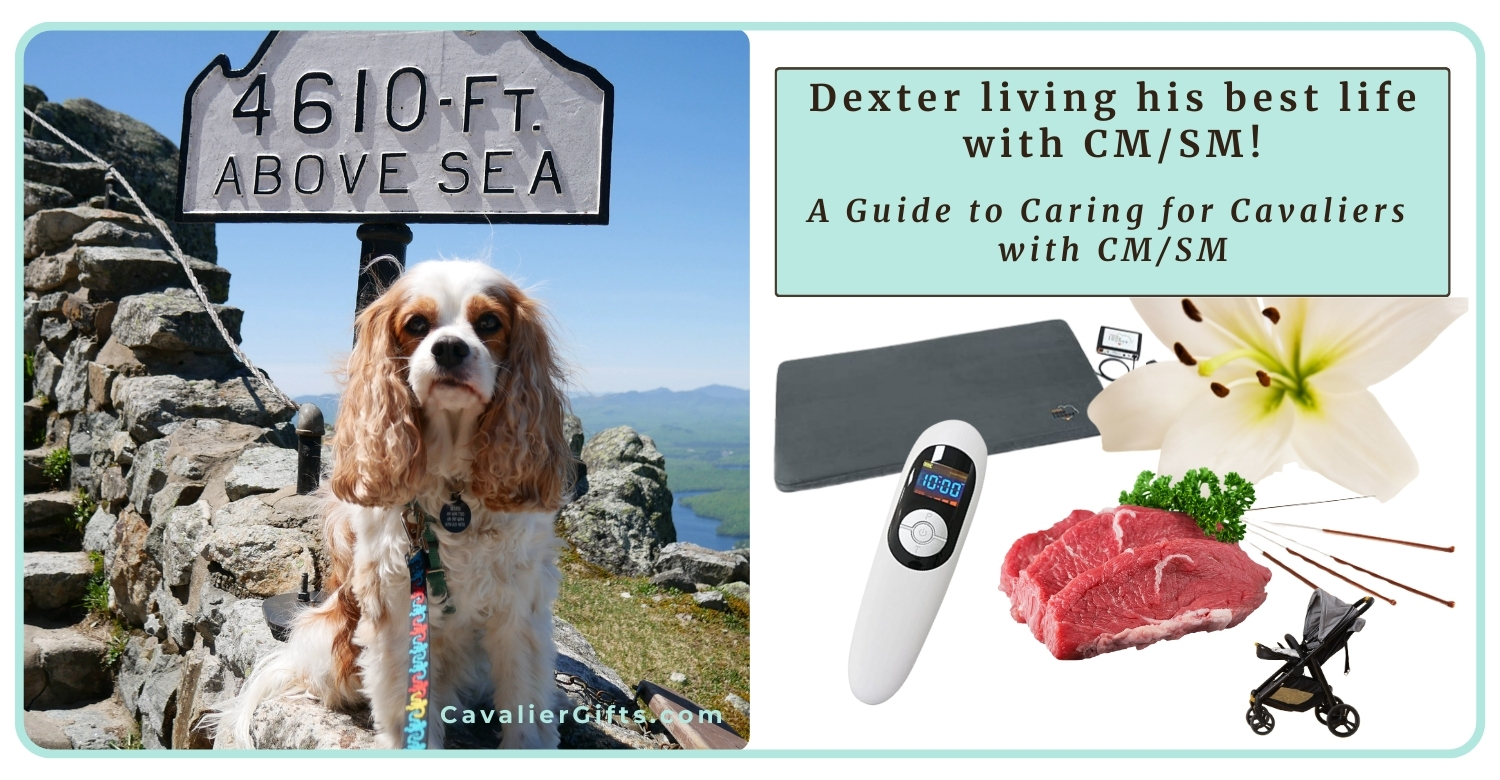

My best friend, Dexter the Dog, was diagnosed with Chiari malformation and syringomyelia in 2012, just before his third birthday. This diagnosis hit me hard. Over the past twelve years, I’ve shared a lot about Dexter’s diagnosis, care, and treatments on my Raising Your Pets Naturally blog and YouTube channel.
Since I recently started this blog dedicated to Cavalier King Charles Spaniels, I thought it would be a good time to write an update on Dexter’s care and what I’ve learned. I am also happy to say that at almost fifteen, Dexter is doing amazingly well! I hope you find this article on Chiari malformation and syringomyelia in dogs helpful. Please share this information to help others dealing with this heartbreaking diagnosis learn about the many helpful and natural treatments for dogs with Chiari malformation and syringomyelia.
[social_warfare]
What is Chiari Malformation (CM) and Syringomyelia (SM)
Chiari malformation commonly affects Cavalier King Charles Spaniels, Chihuahuas, Brussels Griffons, Yorkshire Terriers, Maltese, Pomeranians, Toy Poodles, and Shih Tzus. In dogs with CM, the skull is too small to hold their brain properly. This overcrowding forces parts of the brain, specifically the cerebellum and medulla, out of their normal positions. The cerebellum controls movement and balance, while the medulla is connected to breathing and heart rate.
When these brain parts are pushed out of place, they obstruct the normal flow of cerebrospinal fluid (CSF). Cerebrospinal fluid is in the brain and spinal cord and acts as a natural cushion, protecting the brain. When the flow of CSF is blocked, it can lead to a buildup of pressure and result in serious neurological issues and can form syringomyelia (SM), a condition where fluid-filled cavities form within the spinal cord.
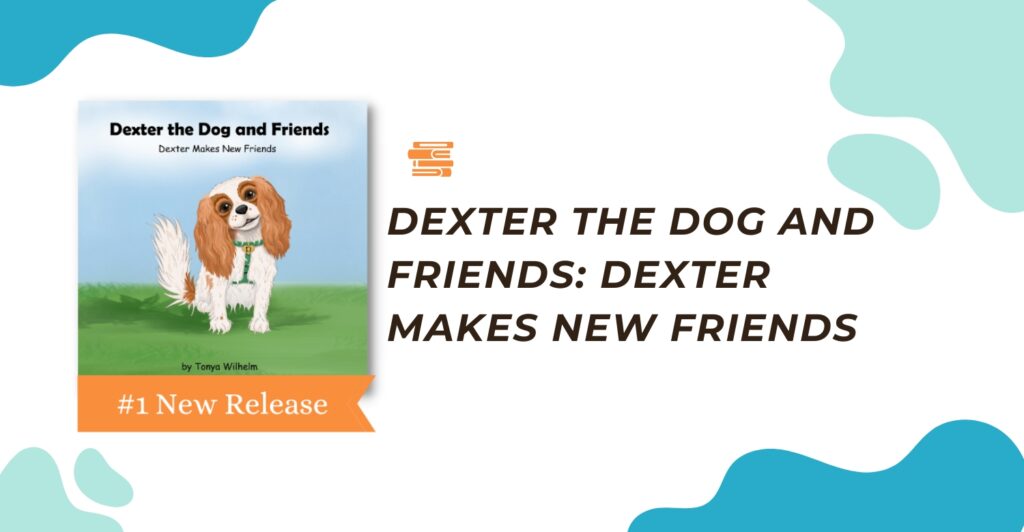
In Cavalier King Charles Spaniels, Chiari malformation is a congenital issue, meaning they are born with it. Dr. Clare Rusbridge established a breeding protocol to help reduce CM/SM in puppies. Following the breeding protocol is crucial for reducing the risk of Chiari malformation (CM) and syringomyelia (SM) in Cavalier King Charles Spaniels. If both parents have CM/SM, puppies are 92 percent likely to be affected, while the risk drops to 77 percent if only one parent is affected. If both parents are clear of CM/SM, there is a 70 percent chance their puppies will be clear, rising to 87 percent if the grandparents are also clear. Potential Cavalier families should seek breeders who perform this testing to ensure healthier puppies. The only way to diagnose Chiari malformation and syringomyelia definitively is through an MRI scan.
Recognizing Chiari malformation is vital for Cavalier King Charles Spaniel families because early detection and treatment can greatly improve the quality of life for dogs with this condition. If you notice symptoms like uncoordinated movements, sensitivity around the head and neck, or any other unusual behaviors, it’s important to consult with your veterinarian as soon as possible.
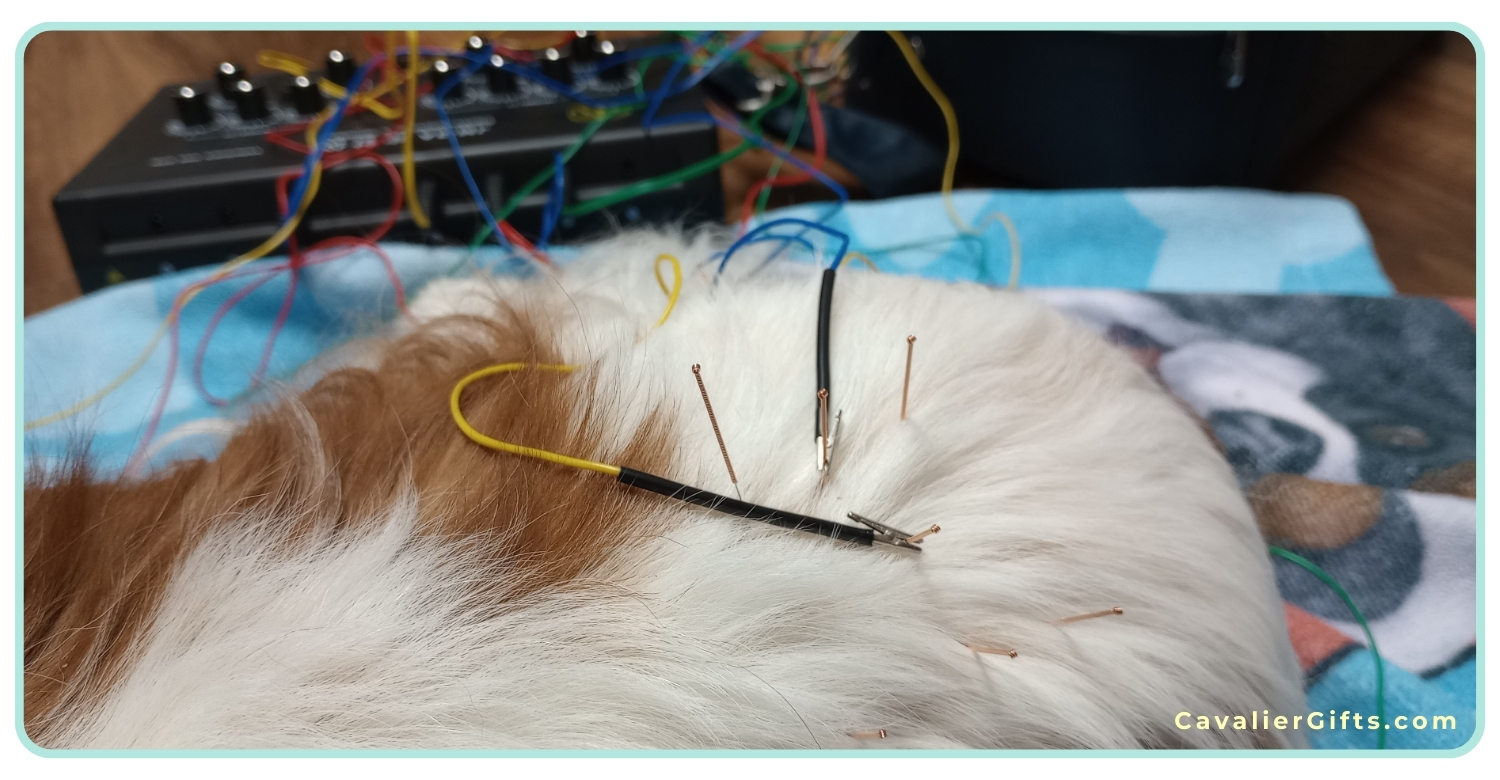
Symptoms of Chiari Malformation and Syringomyelia in Dogs
Symptoms of CM and SM in Cavalier King Charles Spaniels and other breeds can vary. About a year before Dexter’s diagnosis, he began showing some random and unusual behaviors. And they didn’t happen all the time.
- Fixating at dust particles in the sunlight.
- Fidgeting and biting at his rear end. His vet initially thought it was anal glands, but they really weren’t that full, and he continued to do it.
- Acting strangely around flying insects. Whenever a fly was around, he would get strange and start spinning around and growling at his back end.
Then, he had a downright scary episode, where he just was going crazy over his back end, growling, at it, spinning, and I could not gain his attention. I then decided to hit record the next time it happened. After recording the next episode and consulting Dr. Lynette Cole at The Ohio State University, three veterinary neurologists suspected Chiari malformation and syringomyelia. I then made an appointment at the OSU neurology department for an MRI and spinal tap. CM and SM were confirmed.
Dexter’s episode is below.
Don’t forget to subscribe to our @RaisingYourPetsNaturally YouTube channel for more.
Other common symptoms of CM/SM in Cavalier King Charles Spaniels can include:
- Air scratching, especially on walks or when excited.
- Head scratching or rubbing.
- Air snapping or licking.
- Random yelps of pain.
- Sensitivity to touch and being picked up.
- Hind end weakness.
- Head or body wobbles, stumbling, or squinting.
- Head pressing.
- Seeking darkness or solitude.
- Inactivity or depression.
- Restlessness.
Google Ad Below
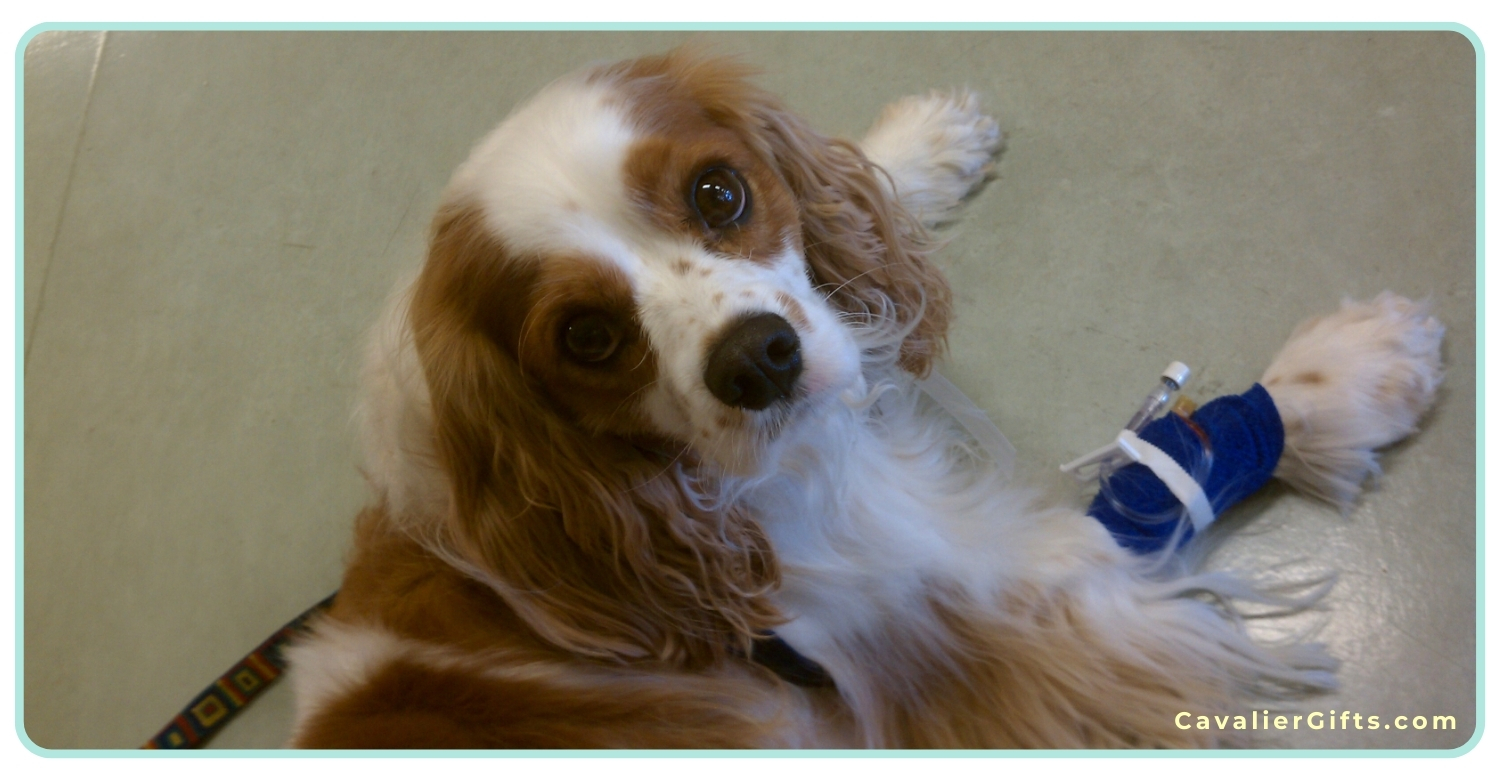
Diagnosing Chiari Malformation and Syringomyelia
The only definitive way to diagnose CM/SM is with an MRI. If a dog shows common symptoms and belongs to a breed prone to this disease, like Cavalier King Charles Spaniels, a vet might start treatment without MRI confirmation. For me, knowing exactly what Dexter had was key. Along with an MRI, Dexter also had a spinal tap to ensure we had all the facts.
Treatment Options for Chiari Malformation and Syringomyelia
Surgery for Chiari Malformation in Cavalier King Charles Spaniels
Surgery is performed with the goal of restoring the natural flow of spinal fluid. This involves decompressing the affected area, removing bone fragments, and sometimes adding a shunt. However, the results can differ greatly from one dog to another. Despite surgical intervention, many dogs still require medication to manage their pain effectively.
Medications for Chiari Malformation in Cavalier King Charles Spaniels
The disease is progressive and varies in severity. Treatment prioritizes comfort and alleviates pain. Dr. Clare Rusbridge provides the gold standard in the medication treatment protocol. It’s essential to monitor organ functions regularly when administering long-term medications.

Natural Treatments for Syringomyelia in Dogs
There are many natural treatments to help support a dog with CM/SM. Here are some that have worked for Dexter:
- Acupuncture: Restores the normal flow of energy through specific pathways.
- Cold Laser Therapy: Reduces inflammation, relieves pain, repairs tissue damage, and increases blood circulation.
- PEMF ( Pulsed Electromagnetic Field) Therapy: Reduces inflammation, relieves pain, promotes tissue and cell repair.
- Food Therapy: A diet of home-cooked or raw dog food helps reduce inflammation. Ingredients like sardines, shiitake mushrooms, and green-lipped mussels can help.
- Conscious Proprioception Exercises: Dexter wore Dr. Buzby’s ToeGrips to stimulate awareness of his feet. I also regularly work with him on footwork exercises to help him be more aware of his feet.
- Canine Hydrotherapy: Water treadmill therapy strengthens Dexter’s body with low joint impact.
- Core Strength Exercises: Dexter’s rehabilitation focuses on boosting his core and back end strength, crucial for enhancing balance and stability. Through a variety of exercises using different equipment, we target his abdominal, back, and hind leg muscles, ensuring he can confidently navigate any challenges.
Living with a Cavalier King Charles Spaniel with Chiari Malformation
Living with a dog diagnosed with Chiari Malformation and syringomyelia can be challenging. Dexter’s first year after diagnosis was the most challenging. Trying to figure out what worked best for him, what kinds of activities or weather would trigger breakthrough pain, and how best to manage it. His life changed, but, luckily, with a great team of professionals, I was and am able to provide Dexter with a great quality of life that is still full of adventures and enrichment.

Comfort Measures
To help keep Dexter as comfortable, happy, and pain-free as possible, I’ve incorporated a range of products.
- Dog Harness: Avoid collars that can be painful due to the disease’s nature.
- Dog Strollers: Great for giving Dexter a break while still being part of adventures.
- Cooling Mats and Warming Blankets: Depending on Dexter’s temperature needs. I will say, now Dexter is on a cooling mat almost 100 percent of his downtime. He rarely seeks heat.
- Snuggle Jackets: Some dogs find comfort in them, while others might not. In the beginning, Dexter wore one almost all the time. But, I think, after we finally found our groove with his care, they were no longer necessary.
- Natural Calming Aids: Calming CDs and natural calming sprays help Dexter on rough days.
Support for Dogs with Chiari Malformation and Syringomyelia
Let’s unite in this journey. Dexter’s courage living with Chiari malformation and syringomyelia serves as a light of hope for us all. You aren’t in this alone. Seek the help of a good veterinarian team, join a support group, including ours! Together, we can provide hope and guidance to others on similar paths. Go Team Dexter!
Your comments and questions are always welcome below.
Join our vibrant Cavalier King Charles Spaniel community on Facebook, support our dedication to pet wellness on Patreon, and stay updated with our weekly newsletter for invaluable tips and insights into raising happy, healthy pets. Together, let’s make a difference in our dogs’ lives!
|
|

|

|

Google Ad Below





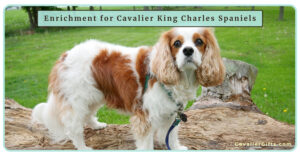


















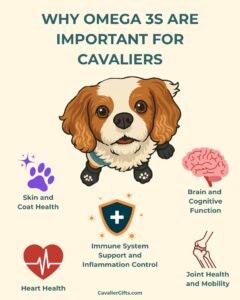

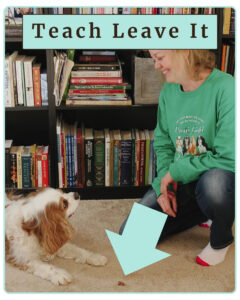
I’m always looking for support and input, dealing with our 6.5 y.o. CKCS with SM/CM. He’s not had an MRI, but when telling my Vet his symptoms that began approx. 3 years ago, the Vet was 100% sure. So now it’s been a little over a year now on Gabapentin, 3x a day, it “helped”, but he still had periodic episodes. About three or four months ago, after hearing about a supplement on Healthy King Charles Facebook page called PEA, I decided to give it a try. Boy did it help, his episodes are rare now, maybe once or twice a week, usually prior to weather changes. It’s been a game changer, but, I’d like to find another tool or two to help control it even more. Dr. Judy’s site has some supplements that I’m thinking about. One has colostrum, green lipped muscle, seaweed, a couple other ingredients. What’s your thoughts, what do you have to add? Foods, supplements, for us on a tight budget. I want my Charlie to have a good life.
I’m so sorry to hear about Charlie. It’s tough for sure. I’m glad the PEA is helping. Dex was also on it. I focused on what I suggested in the blog, along with things that helped reduce inflammation. It’s never just a one and done, more of a synergy. Wishing you the best! 💙Tonya 🌈 Angel Dexter